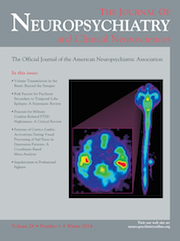Fatal Neuroleptic Malignant Syndrome Induced by Clozapine in Parkinson’s Psychosis
To the Editor: Psychotic symptoms, especially visual hallucinations, are common in Parkinson’s disease (PD). They can appear as a possible side effect of dopaminergic medication, or in the context of processes inherent to the disease itself, as the result of complex mechanisms integrating visual input processing and interpretation through limbic and temporal regions.1
Neuroleptic malignant syndrome (NMS) is a rare and severe life-threatening adverse event associated with antipsychotic therapy. It is characterized by hyperthermia, muscle rigidity, autonomic dysregulation, and laboratory findings such as elevated creatinine phosphokinase (CPK) and leucocytosis.2 Death usually occurs as a result of respiratory failure, disseminated intravascular coagulation, renal failure, and/or cardiovascular collapse.3
Case Report
An 81-year-old woman, with a medical history of PD for many years, medicated with ropinirol and levodopa, presented with confusion, fever, cogwheel muscle rigidity, elevated blood pressure, and urinary incontinence. Two weeks previously, she had started clozapine 100 mg/day for visual hallucinations. She described seeing a man and an elephant in her house and had no other psychopathology, including cognitive disturbance, altered mood, auditory hallucinations, or delusions.
An analytic study showed an increase in blood urea and creatinine. CPK was only mildly elevated. She also had anemia and thrombocytopenia. There was no other abnormality, including WBC. She was admitted for acute renal failure secondary to NMS induced by clozapine and treated with IV fluids, antipyretics, and diazepam. Clozapine was immediately discontinued. Despite treatment, 5 days after admission, the patient died of cardiovascular and renal failure.
Discussion
Psychotic symptoms in PD are a unique clinical challenge, as many antipsychotic agents exacerbate parkinsonism. The most appropriate first-line treatment for PD psychosis involves simplification of the anti-PD medication regimen. Clozapine and quetiapine are the most commonly used antipsychotics, with quetiapine as the first choice because of the need for blood monitoring with clozapine.1
The risk of NMS may increase with higher doses, parenteral administration, and greater potency of antipsychotic drugs. Other risk factors involve the use of concomitant medications such as lithium or metaclopromide, abrupt withdrawal of dopamine agonists, extrapyramidal disorders such as PD, age extremes, alcoholism, catatonia, dehydration, iron deficiency, restraints, and the presence of an organic brain syndrome or previous brain injury.2
NMS induced by clozapine may have atypical features, including lack of muscle rigidity or fever and milder CPK elevation.4 It can occur a few hours to years after starting treatment and is associated with central dopamine hypoactivity and 5-HT1a hyperactivity linked to 5-HT2a receptor blockade by clozapine.5
Treatment of NMS includes supportive measures and discontinuing suspected triggering drugs. Lorazepam and other benzodiazepines may reduce recovery time, because of effects on GABAergic function.4 In most cases, NMS resolves within 2 weeks after antipsychotic drug discontinuation, but, at times, serious complications may occur.2
Although NMS is more prevalent with antipsychotic drugs that are associated with a high degree of extrapyramidal side effects, it can occur with all typical and atypical antipsychotics. A high degree of suspicion is mandatory to institute timely intervention.
1 : Visual hallucinations in the differential diagnosis of parkinsonism. J Neurol Neurosurg Psychiatry 2012; 83:448–452Crossref, Medline, Google Scholar
2 : Neuroleptic malignant syndrome: further lessons from a case report. Psychosomatics 2010; 51:349–354Crossref, Medline, Google Scholar
3 : A case report of neuroleptic malignant syndrome. BMJ Case Rep 2009Crossref, Medline, Google Scholar
4 : Neuroleptic malignant syndrome induced by atypical neuroleptics and responsive to lorazepam. Neuropsychiatr Dis Treat 2006; 2:235–240Crossref, Medline, Google Scholar
5 : Resolution of symptoms in neuroleptic malignant syndrome. Indian J Psychiatry 2010; 52:264–266Crossref, Medline, Google Scholar



